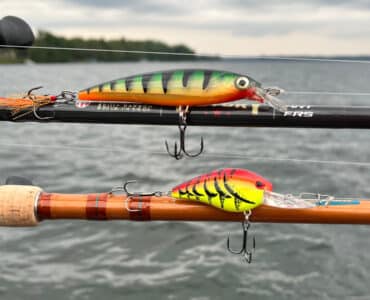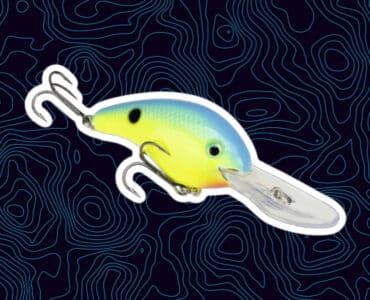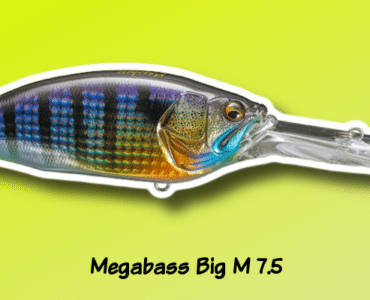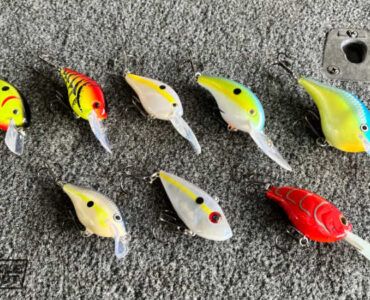If you are new to crankbait fishing, one of the first things you’ll want to learn is how to rig it properly for bass fishing.
Sure, you could just tie one straight on and go fishing, but we have some tips and tricks that can make things go more smoothly.
How to Rig a Crankbait for Bass (How to Tie)
Here are four simple rigging tips for tying on a crankbait. We’ll focus on the connections to the line to get the most lure action while protecting your line.
These rigging methods work well for all crankbait types, including shallow, deep diving, and lipless baits.
1. Tie Your Line Directly to the Split Ring

Like to keep things simple? Just tie your line straight to the split ring that came with your crankbait.
It does not matter if you use monofilament, fluorocarbon, or braid. Make sure to align your knot at the smallest point at the opening, where the split ring does not overlap.
If you tie your knot on the overlap, the line will eventually slip down to the ring opening and potentially fail.
Some crankbait brands, like Strike King, will have an oval split ring. In that case, you need to tie the line on the narrow end of the split ring, even if the wire is overlapping. As you fish the bait, the line will naturally slide to the narrow end.
One good reason NOT to tie directly to the split ring? There is a possibility of your line being weakened by rubbing on the split ring ends.
Look closely, and you can see the knot can (and will) move up against the ends of the split.
After a while, the bill can get worn from smooth plastic to a rough, ragged edge. Maybe it’s just me, but I don’t like my line rubbing against that (during the cast).
2. Replace Round Split Rings with Oval or Teardrop

The second simplest way to rig a crankbait is to swap out the round split ring for an oval or teardrop split ring. I like Owner Teardrop and Owner Oval Split Rings for this task.
The force of casting and pulling the crankbait through the water will pull the line to one end, away from the abrasion points at the split.
You will need a good pair of split ring pliers to remove and replace the stock rings. I like the Texas Tackle Pliers for this job. The slim needle nose design gets into the smallest spaces.
Beware, this can be quite a job. If replacing round split rings works for you, set aside time to change over all your crankbaits in one sitting. It also makes a good winter project.
What Size Oval Split Ring?
Replace standard round splits with #3 or #4 Oval Split Rings. For Teardrops, use #2 and #3 to swap out the round rings.
3. Add a Solid Ring to the Split Ring

Some crankbaits have recessed bills that make replacing the split ring difficult. I like to add a solid ring to the split ring in these situations.
Solid rings can also be added to any crankbait stock split ring or jerkbait. The Owner Solid Rings are smooth all around, making it a secure place to tie off your line.
This method is a good alternative to tying directly to the split ring, reducing the risk of line abrasion without the risk of affecting lure action with a snap.
What Size Solid Ring?
#3.5 solid rings are fine for smaller crankbaits, but they are tiny. #4 is a good all-around size, and #5 is for the biggest deep diving cranks.
4. Tie on a Snap for Easy Lure Change

I like to use a snap with crankbaits. In addition to changing colors or diving depths much quicker, snaps get my line away from the edge of the bill.
I believe the bill can rub on the line during the cast, weakening the line where the pressure is highest. Give the Owner All-Purpose Snaps (Size 1.5 or 2) a try, you will be pleased with how well they work.
Some people feel a snap degrades the action of a crankbait, but I cannot tell the difference. If you are unsure about the action, try a snap with a built-in swivel.
But a swivel is one more place where your connection to the bait can fail but will not impede the diving action of your lure.
What Knot to Use for Crankbaits?
Many knots will work for tying a crankbait, but I have come to rely on just two.
Palomar Knot
This knot is my go-to knot for the majority of my line to lure connections. It’s simple, fast, and incredibly strong when tied correctly.
Tying a Palomar knot on bigger lures like crankbaits takes some practice. A larger loop is needed to wrap around the bait, which can trip people up.
Go a little slower and leave a long tag end to allow for a clean cinching of the knot.
Uni Knot
The Uni knot is another great choice if you struggle with the Palomar. It’s like the Double Uni for joining two lines, but to a split ring instead.
Pass your line through the ring, doubling it up. Come back, make a loop, and wrap 5-6 times around the two strands of line. Wet the line and pull the tag end tight.
Finish by pulling the main line until the knot is tight to the lure connection.
What Size Line for Crankbaits?
Line size is a key factor in rigging crankbaits. A heavier line reduces the maximum diving depth of all crankbaits but is extra insurance against the rock and wood damaging your line.
12 lb. test fluorocarbon strikes a good balance between strength and diving depth. If fishing in heavy rock or brush, I would not hesitate to increase my line to 15 lb. Test.
Stick with fluorocarbon, if possible, as it is much tougher than monofilament. You will spend far more time retying with mono than with fluoro.
Seaguar Red Label fluorocarbon is an excellent line for cranking that is also affordable. For more abrasion resistance, upgrade to Seaguar AbrazX fluorocarbon.
- Use 10lb line with smaller, lighter crankbaits for better casting distance.
- Most of my cranking is done with 12lb line. Strong enough to fight larger fish, light enough to reach the desired depth.
- Upgrade to 15lb using larger, deeper diving crankbaits like the Strike King 6XD.
- The max line sizes should be restricted to the largest crankbaits and the gnarliest cover. Choose 17lb with a Strike King 10XD or fishing in standing timber.
Closing Thoughts
Rigging a crankbait is easy, and we’ve shown you some good tricks. You should try them out yourself and experiment as needed. To summarize how to tie on a crankbait:
- Use 12 lb. Fluorocarbon for most of your cranking. 10 or 15 lb. is also fine.
- When tying direct, replace round split rings with oval or teardrop rings to protect your line.
- Use snaps when you want to change colors and dive depths quickly.
- Tie your line to the crankbait or snap with the Palomar knot.
Tying on a crankbait is not complicated! Get out on the water and experiment, it is the best way to see what you like and build confidence in your setup.
Last updated 2024-04-25 at 18:56 / Affiliate Links & Images from Amazon Product Advertising API















Add comment